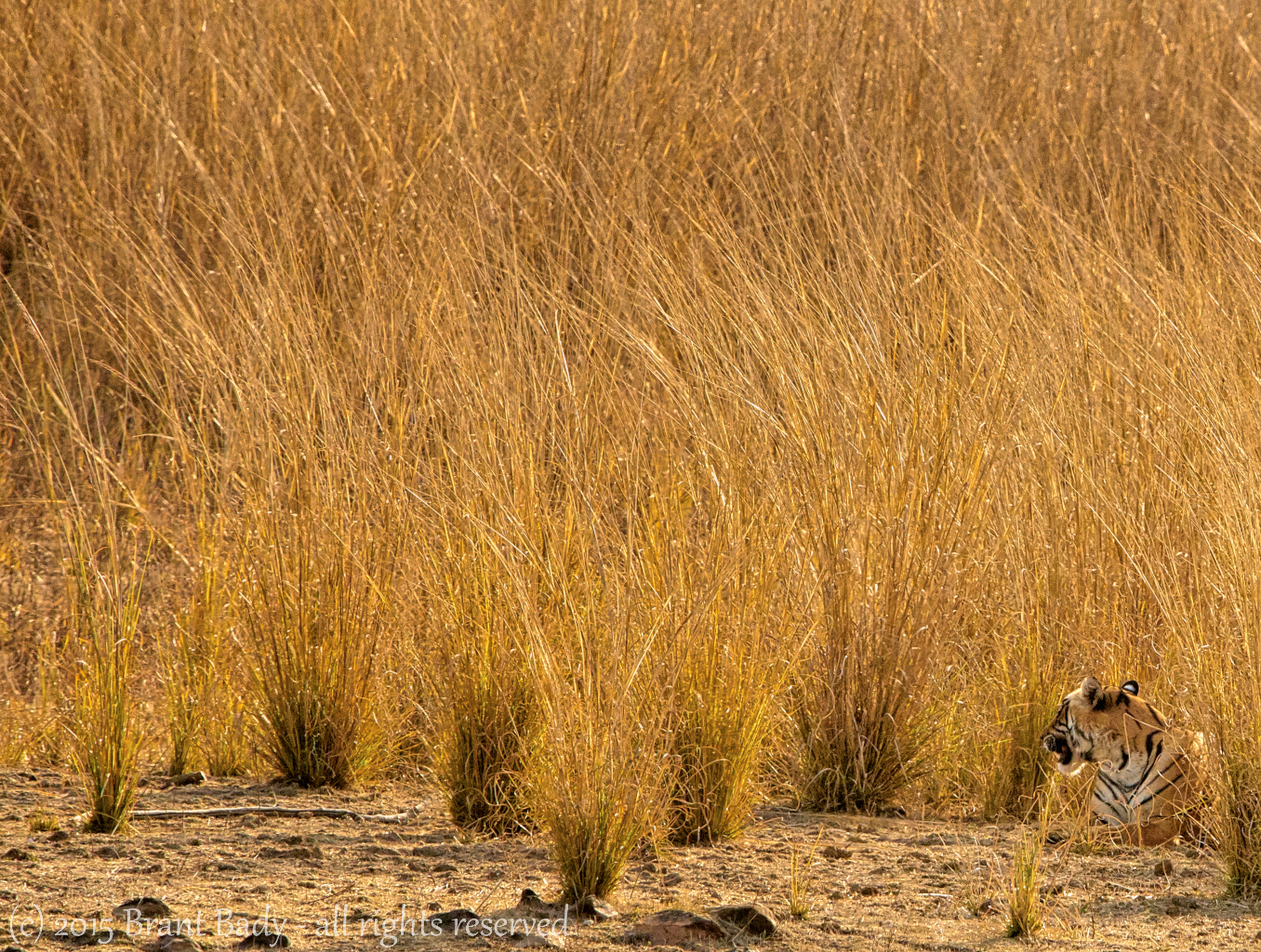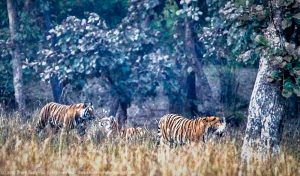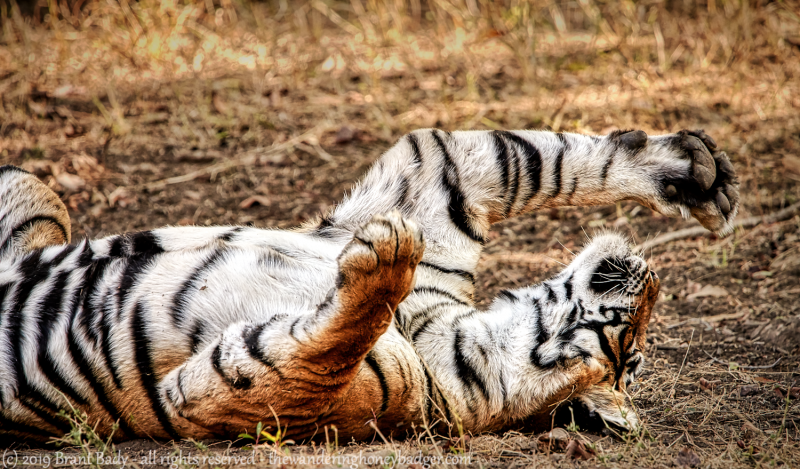This is Part 3 of “On The Tiger Trail” “How I Spent My Winter on Photo-Safaris in Northern India”
“Pussycat, Pussycat, Where are You”
To paraphrase part of the 1960’s song called What’s New Pussycat, the challenge of actually finding a tiger to view presents itself immediately on every safari, and actually the lyrics for that song aren’t a bad anthem for those who seek to view and photograph these magnificent animals.

On my first tiger safari a few years back, I learned that just being in a tiger reserve is no guarantee of seeing a tiger. Each Gypsy vehicle has its own guide and its his or her job to find the tiger for you. Once in your assigned zone (often assigned randomly), you will drive around and your guide will be scanning the soft dust of the roads looking for tiger paw prints (called “Pug Marks”), to indicate that a tiger is in the area. Other indicators are scratches on tree trunks where the tiger has clawed the tree to mark its territory from other tigers (they also spray to leave a scent), and sometimes tiger droppings (one of my guides actually leaned out of our vehicle and poked a piece of tiger spoor to see how fresh it was).
However, the most reliable tiger indicator are the alarm calls made by deer, monkeys and birds to warn their buddies that a tiger is in the area. Sometimes word of mouth also comes into play, unlike Africa, in India my experience has been that most (but not all) National Parks make it difficult or illegal to communicate by radio or cell phone within the park. So the only way information is passed around during the day is with guides in the process of passing each other in jeeps, share sightings, alarm calls, and other signs or strategies.
In my case, I did five safaris where we drove around like madmen looking for a tiger. On my very last safari, I had a brilliant guide who decided we were not going to drive around randomly, instead we were going to park by the lake and keep an eye on the tall grass. He said “I know there is a tiger in the grass somewhere over there, we will just be patient and wait for it to come to us”. Sure enough it did, and we were treated to a few minutes of viewing and the tiger came within 20 ft or so of us.
Tiger Tales of Tiger Tails – “Is that a brown spot on the seat of your pants or are you using adaptive camouflage clothing?”
Prior to your first safari, you might have some trepidation about potentially getting so close to an apex carnivore in an open jeep. However, for the most part the tigers are quite accustomed to the jeeps and people, and basically they just ignore you. So its perfectly safe, that is until its “not”, since like most things in life, on occasion, things can go awry. So lets not sugar coat this, yes indeed there is some risk in doing a tiger safari in India, but far safer I think than traveling around the country in general – at least in my mind, and experience.
A decades old story was recounted to me at Ranthambore, back in the days when the jeeps had front to back seats not side to side. One particular tiger decided to actually jump into the back of the jeep. It clawed several of the people who were eventually emergency airlifted to New Delhi. The incident only ended, and was limited in injury, due to the fact that one extremely brave guide from another jeep ran over and literally pulled the tiger out of the back of the jeep it had leaped into!
On my own winter set of safaris we had just gotten through the gates at Bandargavh one morning, and the line of jeeps were proceeding into the center of the park were all clustered together. Three tigers (a mother and two nearly full grown cubs) were spotted across a distant field, making their way towards us through the jungle and clearings. The jeeps stopped to observe, and spread out along the road (they are not allowed to leave the road), each waited trying to anticipate where exactly the tigers would approach close (if at all). Normally the presence of the jeeps has little to no effect on the path of the tigers, they know they are the boss here and do and go where they want (one exception is that females with young cubs are much more shy and often will elect to just hide in the thick part of the jungle and not come out or expose themselves in order to protect the cubs).

In this case the female appeared to get angry and irritated by the handful of jeeps that were blocking the part of the road she wanted to cross. I was concentrating on trying to get a clear shot of her two offspring, when suddenly I heard a tremendous roar from the right, and out of the corner of my right eye I saw a flash of orange flying through the air, paws and claws out heading towards a group of the jeeps just a bit down the path. It certainly got my attention… and if I was in the direct path of that pissed-off pussycat I reckon it would have put fear into my heart.
While I don’t panic, that roar has a direct effect on the fight or flight responses hardwired into the tiny remnant part of our monkey brains that we evolved from. Luckily it was only a mock charge. But the truth I have learned about the above incident is likely more subtle, it’s not that she was ticked off by the presence of the jeeps, it’s more likely someone in a jeep pointed their arm out at her. In talking with a local naturalist, who knows the personality of pretty much every tiger in the park, he said that he knew which tiger it was just by the behaviour, and apparently she learned it as a cub from her own mother – just point at her, she takes it as a direct threat and she will charge!
For the record, tigers can leap a good thirty feet, and one single swipe of a paw can take off several of your fingers… as evidenced by the most famous tiger attack video in all of India:
https://www.youtube.com/watch?v=T0kzdu_wTM0 which took place at Kaziranga National Park, one of the places I would recommend worth visiting, although not for a finger amputation.
Tiger ‘Tells’
Rule of Thumb: Tail up – Tiger is Happy, Tail down & Twitching – Look Out.

Apparently, like house cats, the mood of a tiger can be read in the position of its tail; a relaxed tiger also has a relaxed tail. A friendly greeting on neutral territory would see the tail carried high and slowly moving back and forth; excitement brings on vigorous swishing, while anger can be seen in a tail which is lowered and twitching. Source: Tiger Territory – http://www.lairweb.org.nz/tiger/
Indian people love their tigers. I have had strangers at the train station in the dead of the night (like 1 am) want to recite to me the whole lineage of tigers (by each tigers name), at a particular park as soon as I he knew I was going there. However Indians also have a very healthy respect and fear of tigers, especially those live where tigers routinely roam. Park wardens are the professionals though, and they are very sanguine (not to mention brave). Re-watch the Kazaringa Tiger in the grass video listed above, and this time pay attention to the few seconds when the park ranger tries to use a thin bamboo switch swatch to beat away the angry tiger that was literally flying towards him.
My overall conclusion, regardless of your circumstances, is that it’s very very wise to get very very excited about seeing a live wild tiger in India!
Photography Tips
If you just have a regular camera or mobile phone, you are likely better off shooting video than stills. Still photography is more impressive with a long telephoto lens. If you do have a camera with inter-changeable lenses, try to beg, borrow or rent a decent quality zoom lens having an upper end range of at least 400mm, or much better 600mm lens or even longer. Cameras with a high number of megapixels are also preferable, because if the animal is small in the frame (i.e. you can’t get any closer to it), then you will likely need to crop a lot, and therefore the extra detail provided will be invaluable.
In terms of technical settings, start with a setting of 1/500th shutter speed, F8 for the aperture, and floating ISO. That is a great “default” place to start, and is normally good except for dawn or dusk when the light is dim and you might need to compromise those settings a bit more. Obviously if the tiger is stationary, one can lower the shutter speed, although if hand holding a long lens, a good rule of thumb is to use the reciprocal of the focal length of the shutter speed, e.g. 1/500 of a second for a 600mm lens. In body camera or lens stabilization can help here if your gear has it available.
Advanced Tip: in an era when almost everyone relies on AWB (automatic white balance) for still photographs, regardless of whether its a consumer level or pro-ish level camera, it’s normally too convenient “not” to use. However, if you are close enough to nearly filling the frame with the orange of the tiger, you might find that your images display with a blue tint to the tiger’s white fur, particularly in the shadows. If you can change the white balance setting to daylight, rather than Auto, your camera will not be fooling into thinking your precious tiger is just a grey card under very very orange light, and it will take less work to fix it in post to make it look more realistic.
After banking a few “record shots” of the animal in the frame – without arbitrary parts cut off due to bad framing, then start to think about trying to capture behaviours when they occur. Of course, great lighting conditions (back-light is always dramatic) and good separation (the animal stands out from the background) will always pay off in terms of better shots.

Tiger Conservation & Challenges
Probably the first question to ask is: do tiger safaris contribute to and support tiger conservation efforts, or do they impede them?
Lets be clear, the two biggest issues currently adversely effecting tiger conservation by far are 1) poaching (like the very recent news about forest departments who arrested 17 persons for allegedly killing and selling tigers’ body parts for black magic) and 2) loss of habitat in the wild due to encroachment by deforestation and human created climate change, and just human interaction.
Right now the current government of India is pro-business so a number of shocking decisions have taken place in recent years that appear to favor those kinds of economic decisions over environmental issues, i.e. highways being built through the middle of areas supporting if not part of tiger reserves.
While there is evidence that tigers in India’s national parks are about 20% more stressed than in other places where tigers don’t come into contact with people, this is more likely due to human/tiger interactions in the context of farming, protecting livestock, elimination of prey species, and sometimes due accidents along transportation corridors.
In Ranthambore National Park for example, only a portion of the park is actually open to tourists for safaris, approximately 18%. Tigers are territorial, hence only subset of the total tiger population in the park is actually exposed for tourism – with some people estimating that those few tigers have seen far more people in total, than the number of people in the world that have seen a live tiger. The impact of increased “awareness” should also not be minimized – i.e. “see the tiger, care about the tiger, fight for the tiger” seems to be the natural progression or evolution of people’s attitudes after the experience. In India, people really get upset and a lot of controversy occurs if a “named” tiger all of a sudden disappears. I believe that public visibility of the tigers, and transparency into how they are managed, are key elements to the long term survival of the species.
The financial benefits of tiger tourism are significant as the revenue generated goes to support both local economies, but more importantly to benefit of the tiger populations itself. These days the tendency is to use some of these proceeds to set aside more territory/habitat as additional buffer zones, even when humans have to be displaced and are relocated to accommodate more room for the tigers.
One fact that can’t be disputed – under the current arrangements, overall tiger populations in India have been increasing in recent years, and that is simply great news! However, 2019 so far has been a really bad year for Tigers in India, with more than 50 tiger deaths only 1/2 way through the year. India should give each and every one of its tigers, leopard, rhinos, lions, bears etc the status of being a PERSON, just like was done elsewhere in the country for a few of the waterways. That would be an equally brilliant way to handle the situation, then the penalty for killing or poaching would be the same as for killing a human. #TigersArePeopleToo.
For more Tiger – see my short video that accompanies this article/post at https://www.youtube.com/watch?v=WXi_fsmef1Y
“Tiger is a large-hearted gentleman with boundless courage and that when he is exterminated – as exterminated he will be unless public opinion rallies to his support – India will be the poorer, having lost the finest of her fauna.” Jim Corbett
